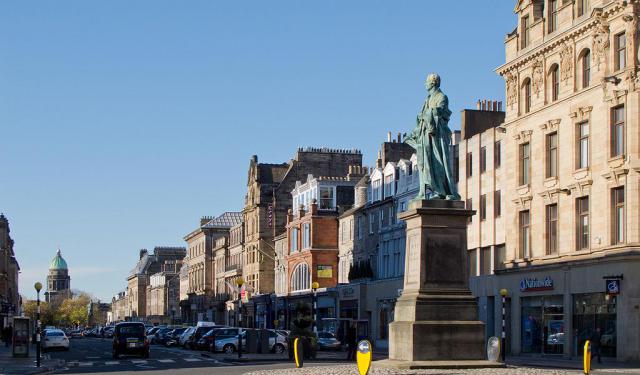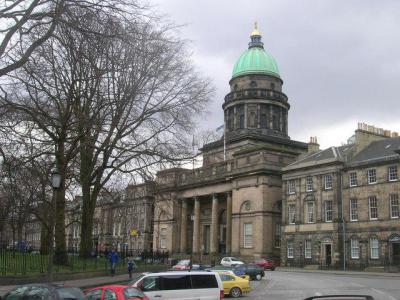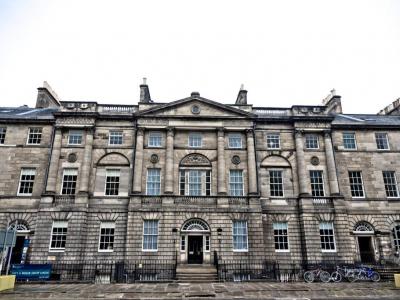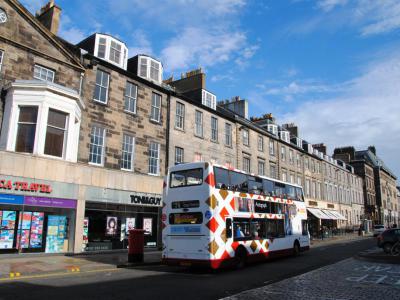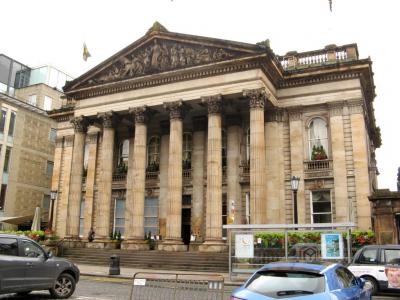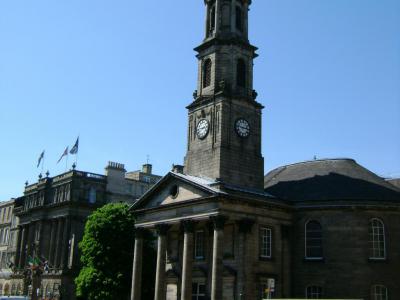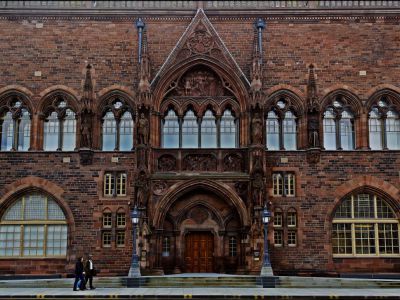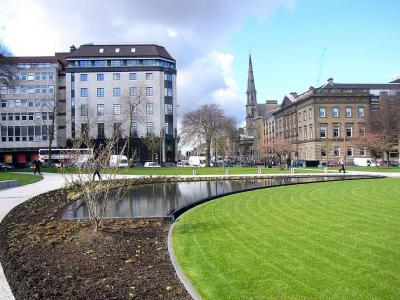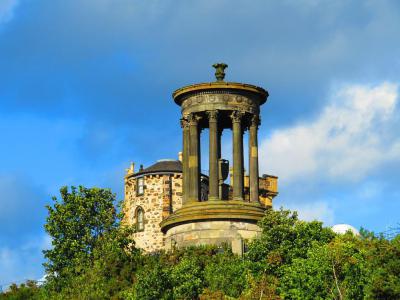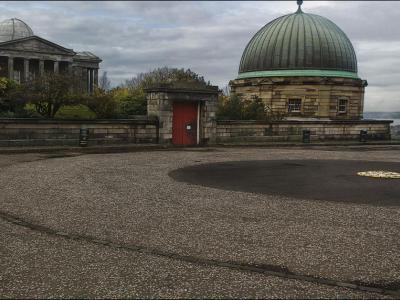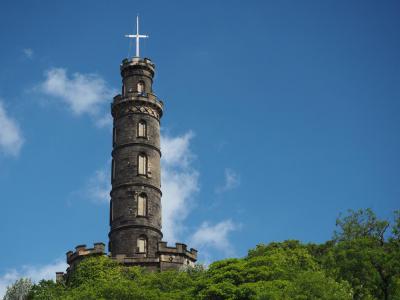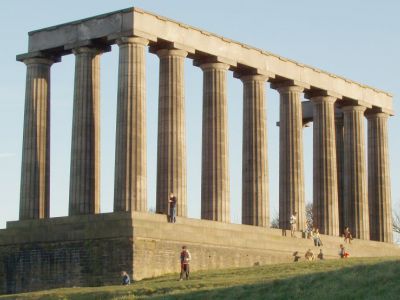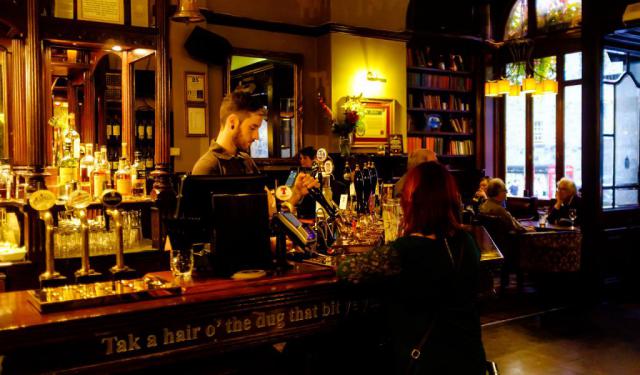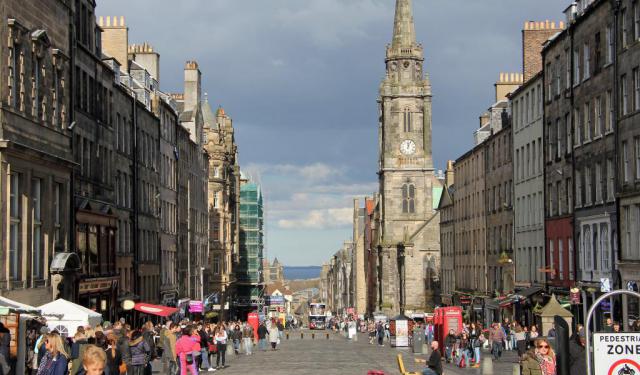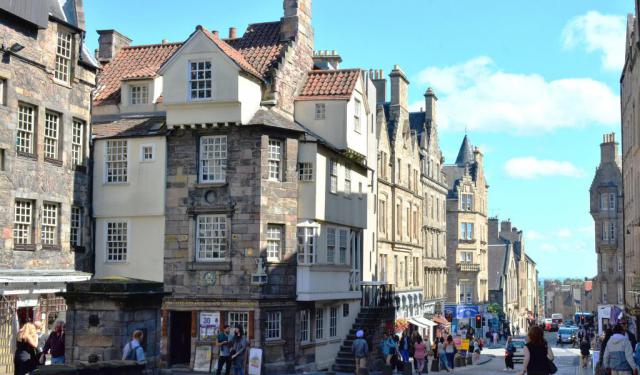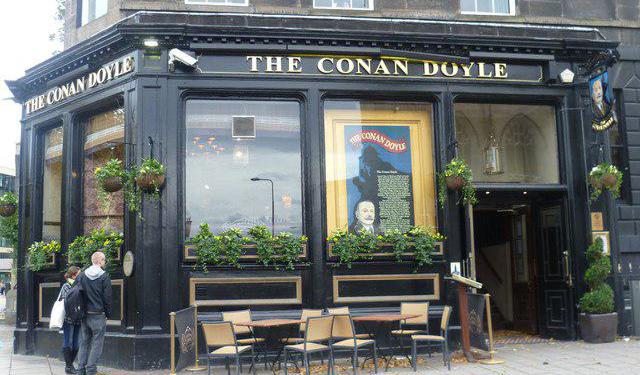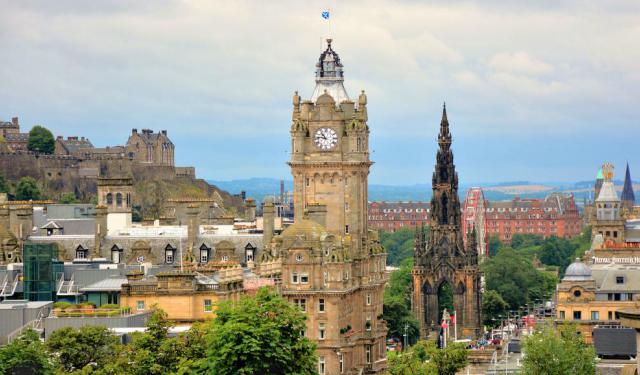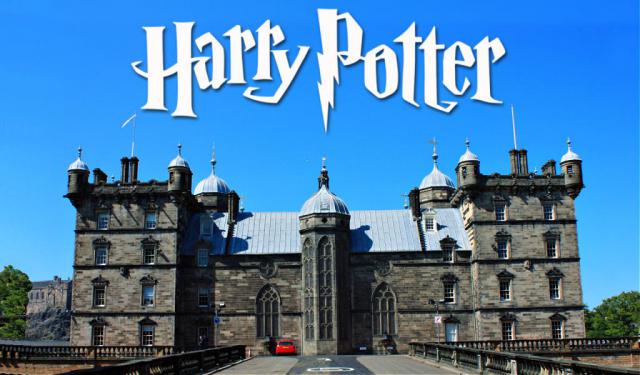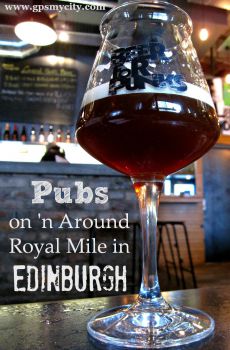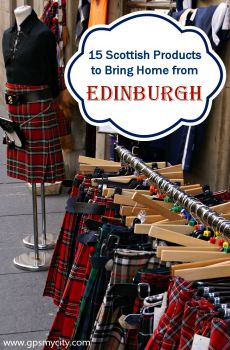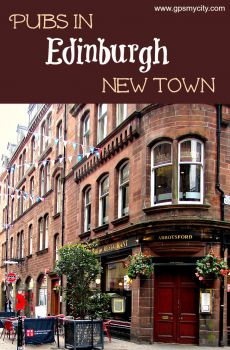New Town Walking Tour (Self Guided), Edinburgh
Rightly regarded as the historic masterpiece of city planning, the New Town of Edinburgh has been a UNESCO World Heritage Site since 1995. The area forms a significant part of the Scottish capital and is known for its elegant Georgian architecture, abundant shopping opportunities, and many other delights firmly associated with this city.
One of the prominent landmarks in the New Town is Charlotte Square, a beautiful garden square lined with impressive Georgian townhouses. Nearby, you can find the Georgian House, a museum that provides a glimpse into the luxurious lifestyle of the upper class during the 18th century.
George Street, another iconic location, is a bustling thoroughfare filled with shops, restaurants, and boutiques. The Dome, a grand building on George Street, houses a bar and restaurant known for its stunning interior decor.
The Parish Church of Saint Andrew's and Saint George's, with its neoclassical facade, stands as a testament to the area's rich history of religious heritage. Meanwhile, the Scottish National Portrait Gallery showcases an extensive collection of portraits that tell the story of Scotland's past.
Saint Andrew Square is a lively hub surrounded by upscale dining and shopping options. The Dugald Stewart Monument, a striking structure on the southern side, pays tribute to a renowned Scottish philosopher.
For breathtaking views of the city, Calton Hill Observatory is a must-visit. It offers panoramic vistas of Edinburgh and is home to the Nelson Monument and the National Monument, both of historical significance and resembling ancient Greek architecture.
The New Town is a treasure trove of options for a meaningful time out. Whether you're interested in exploring museums, enjoying fine dining, or simply taking in the stunning cityscape, this part of Edinburgh has it all. So, plan your visit today and discover the New Town's unique blend of past and present that makes it a jewel in the heart of the Scottish capital.
One of the prominent landmarks in the New Town is Charlotte Square, a beautiful garden square lined with impressive Georgian townhouses. Nearby, you can find the Georgian House, a museum that provides a glimpse into the luxurious lifestyle of the upper class during the 18th century.
George Street, another iconic location, is a bustling thoroughfare filled with shops, restaurants, and boutiques. The Dome, a grand building on George Street, houses a bar and restaurant known for its stunning interior decor.
The Parish Church of Saint Andrew's and Saint George's, with its neoclassical facade, stands as a testament to the area's rich history of religious heritage. Meanwhile, the Scottish National Portrait Gallery showcases an extensive collection of portraits that tell the story of Scotland's past.
Saint Andrew Square is a lively hub surrounded by upscale dining and shopping options. The Dugald Stewart Monument, a striking structure on the southern side, pays tribute to a renowned Scottish philosopher.
For breathtaking views of the city, Calton Hill Observatory is a must-visit. It offers panoramic vistas of Edinburgh and is home to the Nelson Monument and the National Monument, both of historical significance and resembling ancient Greek architecture.
The New Town is a treasure trove of options for a meaningful time out. Whether you're interested in exploring museums, enjoying fine dining, or simply taking in the stunning cityscape, this part of Edinburgh has it all. So, plan your visit today and discover the New Town's unique blend of past and present that makes it a jewel in the heart of the Scottish capital.
How it works: Download the app "GPSmyCity: Walks in 1K+ Cities" from Apple App Store or Google Play Store to your mobile phone or tablet. The app turns your mobile device into a personal tour guide and its built-in GPS navigation functions guide you from one tour stop to next. The app works offline, so no data plan is needed when traveling abroad.
New Town Walking Tour Map
Guide Name: New Town Walking Tour
Guide Location: Scotland » Edinburgh (See other walking tours in Edinburgh)
Guide Type: Self-guided Walking Tour (Sightseeing)
# of Attractions: 11
Tour Duration: 2 Hour(s)
Travel Distance: 2.5 Km or 1.6 Miles
Author: Helen
Sight(s) Featured in This Guide:
Guide Location: Scotland » Edinburgh (See other walking tours in Edinburgh)
Guide Type: Self-guided Walking Tour (Sightseeing)
# of Attractions: 11
Tour Duration: 2 Hour(s)
Travel Distance: 2.5 Km or 1.6 Miles
Author: Helen
Sight(s) Featured in This Guide:
- Charlotte Square
- Georgian House
- George Street
- The Dome
- Parish Church of St. Andrew's and St. George's
- Scottish National Portrait Gallery
- St. Andrew Square
- Dugald Stewart Monument
- Calton Hill Observatory
- Nelson Monument
- National Monument
1) Charlotte Square
Marking the west end of George Street, Charlotte Square was constructed as a complement to St Andrew Square that is found on the opposite – east – end of the same street.
The square was named after King George III’s first daughter. Its construction began in 1820 and the last part of it, the north-west corner, was completed only in the 1990s, with the original plan duly adhered to, so there is nothing in its appearance suggesting a modern look.
The Number 5 house on the north side of the square is the former residence of John-Crichton-Stuart. Upon his death, the property was bequeathed to the National Trust of Scotland, and today it accommodates the Edinburgh World Heritage Trust headquarters.
Number 6, the Bute House, is also owned by the National Trust of Scotland and is the official home of the First Minister of Scotland. Number 7, the Georgian House, is the third National Trust of Scotland building in the square and is currently a house museum, open to the public.
In the square’s gardens there is a fine equestrian memorial statue of Prince Albert, Queen Victoria’s husband, erected by Sir John Steell. The gardens are open only to the local residents though, except in August, when for three weeks it hosts the Edinburgh International Book Festival.
The square was named after King George III’s first daughter. Its construction began in 1820 and the last part of it, the north-west corner, was completed only in the 1990s, with the original plan duly adhered to, so there is nothing in its appearance suggesting a modern look.
The Number 5 house on the north side of the square is the former residence of John-Crichton-Stuart. Upon his death, the property was bequeathed to the National Trust of Scotland, and today it accommodates the Edinburgh World Heritage Trust headquarters.
Number 6, the Bute House, is also owned by the National Trust of Scotland and is the official home of the First Minister of Scotland. Number 7, the Georgian House, is the third National Trust of Scotland building in the square and is currently a house museum, open to the public.
In the square’s gardens there is a fine equestrian memorial statue of Prince Albert, Queen Victoria’s husband, erected by Sir John Steell. The gardens are open only to the local residents though, except in August, when for three weeks it hosts the Edinburgh International Book Festival.
2) Georgian House
The Georgian House in Edinburgh, is an 18th-century townhouse that has been meticulously restored and furnished by the National Trust for Scotland. Today, it operates as a popular tourist attraction.
This historic site is one of the most frequently visited places within the National Trust for Scotland (NTS) portfolio, drawing over 40,000 visitors annually, ranging from local schoolchildren to tourists from around the world. A dedicated team of more than 200 local volunteers plays a crucial role in maintaining the house's operation. Most of these volunteers serve as 'room guides,' offering insights and assistance to the visitors. The house's furnishings and fittings primarily date back to the late Georgian period (approximately 1760-1830), although some items have even older origins.
Upon arrival at the Georgian House, visitors are welcomed at the reception located in the Hallway. This is where admission tickets are issued, and a staff member or volunteer provides an introduction to the house, guiding visitors in the direction they should take to start their tour. Unlike guided tours, visitors have the freedom to explore the property at their own pace. In each of the main rooms, a volunteer guide is available to answer any questions and provide information.
The Georgian House is open to the public from March 1st to November 30th. Operating hours during most of the season are from 10 am to 5 pm, with the last admission allowed at 4:30 pm.
This historic site is one of the most frequently visited places within the National Trust for Scotland (NTS) portfolio, drawing over 40,000 visitors annually, ranging from local schoolchildren to tourists from around the world. A dedicated team of more than 200 local volunteers plays a crucial role in maintaining the house's operation. Most of these volunteers serve as 'room guides,' offering insights and assistance to the visitors. The house's furnishings and fittings primarily date back to the late Georgian period (approximately 1760-1830), although some items have even older origins.
Upon arrival at the Georgian House, visitors are welcomed at the reception located in the Hallway. This is where admission tickets are issued, and a staff member or volunteer provides an introduction to the house, guiding visitors in the direction they should take to start their tour. Unlike guided tours, visitors have the freedom to explore the property at their own pace. In each of the main rooms, a volunteer guide is available to answer any questions and provide information.
The Georgian House is open to the public from March 1st to November 30th. Operating hours during most of the season are from 10 am to 5 pm, with the last admission allowed at 4:30 pm.
3) George Street
George Street serves as the primary thoroughfare in the First New Town of Edinburgh, which was meticulously planned by James Craig in the 18th century. The street derives its name from King George III and spans from Saint Andrew Square in the east to Charlotte Square in the west.
Originally established in 1767, George Street was conceived as a residential area. However, during the Victorian era, all the residential dwellings gave way to a transformation into a bustling commercial district, featuring shops, showrooms, banks, small department stores, and hotels. Notably, numerous grand architectural structures in this vicinity were crafted by the renowned Victorian architect David Bryce, who happened to reside on this very street.
In the contemporary 21st century landscape, George Street still retains its Victorian charm, but there has been a shift in the nature of its commercial establishments. Many of the edifices now house an array of restaurants, coffee shops, bars, and upscale clothing boutiques.
Originally established in 1767, George Street was conceived as a residential area. However, during the Victorian era, all the residential dwellings gave way to a transformation into a bustling commercial district, featuring shops, showrooms, banks, small department stores, and hotels. Notably, numerous grand architectural structures in this vicinity were crafted by the renowned Victorian architect David Bryce, who happened to reside on this very street.
In the contemporary 21st century landscape, George Street still retains its Victorian charm, but there has been a shift in the nature of its commercial establishments. Many of the edifices now house an array of restaurants, coffee shops, bars, and upscale clothing boutiques.
4) The Dome
The Dome is a historic building located on George Street in the New Town area. It is categorized as a Grade A listed building and currently serves as a combination of a bar, restaurant, and nightclub, managed by the Caledonian Heritable group. This structure was originally constructed in 1847 to serve as the headquarters for the Commercial Bank of Scotland, and it was designed by the architect David Rhind in a Graeco-Roman architectural style.
Interestingly, The Dome is situated on the site where the old Physicians' Hall used to stand. The Physicians' Hall was the offices of the Royal College of Physicians of Edinburgh and was built in the 18th century according to the design by architect James Craig, who was also the planner of the New Town. When The Dome was built, parts of the frontage of the Physicians' Hall were incorporated into the new structure, including the impressive Corinthian columns.
During the time of its construction, The Dome represented a significant architectural shift in Scotland, reflecting the emergence of capitalism. David Rhind, the architect, drew inspiration from ancient Greek society to capture the ideology of the era in his design for the Commercial Bank building. Rhind emphasized both societal values and aesthetics. In April 1847, The Scotsman newspaper praised the building for its "rich and massive architecture" and "gorgeous" interior decoration.
One notable architectural feature of The Dome is its use of natural light, thanks to the inclusion of a glass dome. The building also maximizes space with a spacious central lobby. While George Street boasts several Greek Revival-style buildings today, The Dome stands out due to its striking pediment and its long and storied history.
Interestingly, The Dome is situated on the site where the old Physicians' Hall used to stand. The Physicians' Hall was the offices of the Royal College of Physicians of Edinburgh and was built in the 18th century according to the design by architect James Craig, who was also the planner of the New Town. When The Dome was built, parts of the frontage of the Physicians' Hall were incorporated into the new structure, including the impressive Corinthian columns.
During the time of its construction, The Dome represented a significant architectural shift in Scotland, reflecting the emergence of capitalism. David Rhind, the architect, drew inspiration from ancient Greek society to capture the ideology of the era in his design for the Commercial Bank building. Rhind emphasized both societal values and aesthetics. In April 1847, The Scotsman newspaper praised the building for its "rich and massive architecture" and "gorgeous" interior decoration.
One notable architectural feature of The Dome is its use of natural light, thanks to the inclusion of a glass dome. The building also maximizes space with a spacious central lobby. While George Street boasts several Greek Revival-style buildings today, The Dome stands out due to its striking pediment and its long and storied history.
5) Parish Church of St. Andrew's and St. George's
While in Edinburgh, you may want to visit the Parish Church of Saint Andrew’s and Saint George’s, the first church that was built in the city’s New Town.
When James Craig designed the New Town, he set aside two parcels of land for two churches: one at the west end to be dedicated to Saint George, and the other, at the east end – to Saint Andrew.
Unfortunately, Sir Lawrence Dundus, who wanted the plot on the east end for his new house, quickly bought it, leaving a plot in the middle of the street. The planners decided that two churches couldn’t be built so close to one another, so the plans for Saint George’s church were set aside and Saint Andrew’s was built in 1780, dedicated to both saints altogether.
The building has an elliptical plan and was the first church of this architectural style in the land. In the 18th century, classical Roman architecture was in fashion, so the church has a temple-like portico and ceiling rosettes, based on Robert Wood’s 1753 examples found in a temple in Syria.
The steeple, built in 1787, houses eight peal bells that were cast by William and Thomas Mears in 1788. These are the last peal bells and the only surviving Georgian bells in Scotland.
The original 18th century windows were replaced by stained glass windows by Alfred Webster and Douglas Strachan in 1912 and 1934 respectively.
When James Craig designed the New Town, he set aside two parcels of land for two churches: one at the west end to be dedicated to Saint George, and the other, at the east end – to Saint Andrew.
Unfortunately, Sir Lawrence Dundus, who wanted the plot on the east end for his new house, quickly bought it, leaving a plot in the middle of the street. The planners decided that two churches couldn’t be built so close to one another, so the plans for Saint George’s church were set aside and Saint Andrew’s was built in 1780, dedicated to both saints altogether.
The building has an elliptical plan and was the first church of this architectural style in the land. In the 18th century, classical Roman architecture was in fashion, so the church has a temple-like portico and ceiling rosettes, based on Robert Wood’s 1753 examples found in a temple in Syria.
The steeple, built in 1787, houses eight peal bells that were cast by William and Thomas Mears in 1788. These are the last peal bells and the only surviving Georgian bells in Scotland.
The original 18th century windows were replaced by stained glass windows by Alfred Webster and Douglas Strachan in 1912 and 1934 respectively.
6) Scottish National Portrait Gallery (must see)
The Scottish National Portrait Gallery is a wonderful place to spend an afternoon. It holds the most important collection of portraits of Scottish personalities in the UK, and is also home to the Scottish National Photo Collection.
The gallery is housed in a Gothic Revival edifice, commissioned by the owner of The Scotsman newspaper, John Ritchie Findlay, and was built in 1890 from red sandstone, being the first building in the world constructed especially for the purpose of being a portrait gallery. It was renovated in 2009 and reopened in 2011.
Here, you will find over 3,000 paintings and sculptures, 25,000 drawings and prints, and over 38,000 photos. The collection begins in the Renaissance period and features the clergy, notable nobles and royalty. The oldest portrait on display is that of James IV of Scotland, painted in 1507.
There are two portraits of Mary, Queen of Scots, but they were painted from memory after her death in 1587. Several other paintings, representing scenes from her life, were executed in the 19th century.
The collection continues to the present day and contains portraits of Billy Connelly, the famous Scottish stand-up comedian, and Robbie Coltrane, the actor best known for his role of Hagrid in the Harry Potter films.
Why You Should Visit:
This baroque building's interior is just lovely and special.
Free admission, good café with a wide range of food, free wifi and toilets.
The well-curated portraits/photography collections give an excellent history of Scotland.
Tip:
Don't miss the lovely pebble mosaic in the charming adjacent courtyard (on the right when facing the gallery entrance).
The entrance hall is also very detailed – make sure you take a look at the ceiling.
The gallery is housed in a Gothic Revival edifice, commissioned by the owner of The Scotsman newspaper, John Ritchie Findlay, and was built in 1890 from red sandstone, being the first building in the world constructed especially for the purpose of being a portrait gallery. It was renovated in 2009 and reopened in 2011.
Here, you will find over 3,000 paintings and sculptures, 25,000 drawings and prints, and over 38,000 photos. The collection begins in the Renaissance period and features the clergy, notable nobles and royalty. The oldest portrait on display is that of James IV of Scotland, painted in 1507.
There are two portraits of Mary, Queen of Scots, but they were painted from memory after her death in 1587. Several other paintings, representing scenes from her life, were executed in the 19th century.
The collection continues to the present day and contains portraits of Billy Connelly, the famous Scottish stand-up comedian, and Robbie Coltrane, the actor best known for his role of Hagrid in the Harry Potter films.
Why You Should Visit:
This baroque building's interior is just lovely and special.
Free admission, good café with a wide range of food, free wifi and toilets.
The well-curated portraits/photography collections give an excellent history of Scotland.
Tip:
Don't miss the lovely pebble mosaic in the charming adjacent courtyard (on the right when facing the gallery entrance).
The entrance hall is also very detailed – make sure you take a look at the ceiling.
7) St. Andrew Square
If you want to spend a little time out visiting Edinburgh’s marvellous houses and museums, but don’t feel up to a long walk, the best place to go is Saint Andrew Square. This square was constructed in 1772 as the first part of James Craig’s design for the New Town.
The lovely houses surrounding it were once homes of the city’s elite, and Dundas House, on the east side of the square, is a fine example of the 18th century architecture. There are also some up-market designer shops, restaurants and pubs to be found here. But the best part about this square is undoubtedly the gardens. Once open to the local residents only, they are now a favourite summer spot for tourists and those who work in the area.
In the middle of the lovely gardens you will find the Melville Monument. It was erected in 1823 in honour of the 1st Viscount of Melville, Henry Dundas, a politician who wielded so much power in his day that was dubbed the “uncrowned king of Scotland”. The monument was designed by great architect, William Burn, who modelled it on Trajan’s Column in Rome, but without intricate inscriptions.
On the south-west side of the gardens is a small pond with benches around it. The lawns are well-kept and there is an air of tranquillity about this place, even if cars and buses somewhat break the illusion of being in the countryside. The gardens have an excellent pavilion café that serves snacks, tea, coffee and soft drinks.
The lovely houses surrounding it were once homes of the city’s elite, and Dundas House, on the east side of the square, is a fine example of the 18th century architecture. There are also some up-market designer shops, restaurants and pubs to be found here. But the best part about this square is undoubtedly the gardens. Once open to the local residents only, they are now a favourite summer spot for tourists and those who work in the area.
In the middle of the lovely gardens you will find the Melville Monument. It was erected in 1823 in honour of the 1st Viscount of Melville, Henry Dundas, a politician who wielded so much power in his day that was dubbed the “uncrowned king of Scotland”. The monument was designed by great architect, William Burn, who modelled it on Trajan’s Column in Rome, but without intricate inscriptions.
On the south-west side of the gardens is a small pond with benches around it. The lawns are well-kept and there is an air of tranquillity about this place, even if cars and buses somewhat break the illusion of being in the countryside. The gardens have an excellent pavilion café that serves snacks, tea, coffee and soft drinks.
8) Dugald Stewart Monument
Edinburgh’s Calton Hill is a fascinating place to visit, replete with fine buildings and monuments. Some of these monuments commemorate famous people, others – events, but the Dugald Stewart Monument is a mystery for many to this very day. Just who was this Dugald Stewart and who had a monument raised in his name?
To answer the second part of the question – the monument was commissioned by the Royal Society of Edinburgh in 1831. It was designed by William Henry Playfair, who modelled it on the Choragic Monument of Lysicrate in Athens, and is one of the many Greek Revival structures in the Calton Hill area.
Answer to the first part of the question – Dugald Stewart was a Scottish Enlightenment Philosopher who was responsible for the predominance of Scottish Philosophy in Europe at the early 19th century. He held the chair of Moral Philosophy (Ethics) at the University of Edinburgh, from 1785 to 1810, and although his ideals are considered out of date today, and he is mostly forgotten, in his day he was highly respected for his views.
The Scottish Enlightment Movement, of which Stewart was an important member, believed that man, guided by reason and virtue, could bring about great changes for the better in nature and society.
To answer the second part of the question – the monument was commissioned by the Royal Society of Edinburgh in 1831. It was designed by William Henry Playfair, who modelled it on the Choragic Monument of Lysicrate in Athens, and is one of the many Greek Revival structures in the Calton Hill area.
Answer to the first part of the question – Dugald Stewart was a Scottish Enlightenment Philosopher who was responsible for the predominance of Scottish Philosophy in Europe at the early 19th century. He held the chair of Moral Philosophy (Ethics) at the University of Edinburgh, from 1785 to 1810, and although his ideals are considered out of date today, and he is mostly forgotten, in his day he was highly respected for his views.
The Scottish Enlightment Movement, of which Stewart was an important member, believed that man, guided by reason and virtue, could bring about great changes for the better in nature and society.
9) Calton Hill Observatory
Sadly, closed to the public since 2009 for safety reasons, following vandalism and theft of the roofing materials, the Calton Hill Observatory is still worth the climb up the hill all the same, if only to see this remarkable building.
The idea of putting an observatory on top of the hill arose at the end of the 16th century when Thomas Short inherited a 12-foot reflecting telescope designed by his brother. The building was architected by James Craig and funded by the University of Edinburgh on the condition that the observatory would be used by its students. However, after the Gothic tower on the southwest corner of the site was completed, the money ran out and the land reverted to the city in 1807.
In 1812, the city council donated the land to the Edinburgh Astronomical Institute, and in 1818, the central building, which resembles a Greek temple, was erected, designed by William Henry Playfair. A 6-inch refractor telescope was installed in the central dome and a 6.4-inch transit telescope took its place in the eastern wing.
The building became the Royal Observatory in 1822, but due to the lack of funding, it was given back to the government in 1847. In 1888, the site of the Royal Observatory was moved to Blackford Hill and, for many years afterwards, the Calton Hill Observatory had been used by the Astronomical Society of Edinburgh before it was abandoned and left vacant.
During its lifetime, the site’s main purpose was to measure time. Astronomers used the transit of certain stars through the Meridian to keep the Observatory’s clock accurate for navigation purposes. For many decades, all the ships docking in the port of Edinburgh brought their chronometers here to be adjusted.
Why You Should Visit:
Offers excellent views of not only the bridge and the Kingdom of Fife, but also of Arthur's Seat.
There are oodles of grass for people to picnic, watch sunsets and to absorb the city from up high.
Right on top is the Collective Gallery, if you're interested in contemporary art.
Tip:
While a visit is free of charge and open to all, best bring some cash with you in case you want to pay a small fee to climb the lighthouse.
The idea of putting an observatory on top of the hill arose at the end of the 16th century when Thomas Short inherited a 12-foot reflecting telescope designed by his brother. The building was architected by James Craig and funded by the University of Edinburgh on the condition that the observatory would be used by its students. However, after the Gothic tower on the southwest corner of the site was completed, the money ran out and the land reverted to the city in 1807.
In 1812, the city council donated the land to the Edinburgh Astronomical Institute, and in 1818, the central building, which resembles a Greek temple, was erected, designed by William Henry Playfair. A 6-inch refractor telescope was installed in the central dome and a 6.4-inch transit telescope took its place in the eastern wing.
The building became the Royal Observatory in 1822, but due to the lack of funding, it was given back to the government in 1847. In 1888, the site of the Royal Observatory was moved to Blackford Hill and, for many years afterwards, the Calton Hill Observatory had been used by the Astronomical Society of Edinburgh before it was abandoned and left vacant.
During its lifetime, the site’s main purpose was to measure time. Astronomers used the transit of certain stars through the Meridian to keep the Observatory’s clock accurate for navigation purposes. For many decades, all the ships docking in the port of Edinburgh brought their chronometers here to be adjusted.
Why You Should Visit:
Offers excellent views of not only the bridge and the Kingdom of Fife, but also of Arthur's Seat.
There are oodles of grass for people to picnic, watch sunsets and to absorb the city from up high.
Right on top is the Collective Gallery, if you're interested in contemporary art.
Tip:
While a visit is free of charge and open to all, best bring some cash with you in case you want to pay a small fee to climb the lighthouse.
10) Nelson Monument
Another monument worth visiting, while on Calton Hill, is the Nelson Monument. It honours Horatio Nelson’s victory at the Battle of Trafalgar in 1805 and his subsequent death from wounds sustained during that battle.
The monument was put up in 1815 on the highest point of the hill, on the site where a mast was once used to send signals to ships entering the Firth of Forth. It was designed by architect Robert Burn in the appropriate form of an up-ended telescope. The monument stands 32 metres high and its 143 stairs lead to the public gallery, from where one can enjoy a wonderful view of the city and the Firth.
In 1853, the Astronomer Royal of Scotland, Charles Piazzi Smith, commissioned a time ball to be placed on top of the monument. The ball was connected to the City Observatory by an underground wiring system. Each day, just before one o’clock in the afternoon, the ball was raised and at 1pm precisely it was lowered. Ships in the Firth set their marine chronometers by the time ball. Accurate time-keeping helped sailors determine their longitude once they were at sea.
The time ball remained in use until 2007 when it was damaged in a storm. It was restored and brought back into use in 2009, but now, with the City Observatory closed, the raising and lowering of the ball is done mechanically from a room at the bottom of the monument.
Why You Should Visit:
The stair takes a while and the parapet at the top is very narrow; still, the photo shots of Princes Street and open sea down below, taken from here, are really stunning and well worth it.
Tip:
£5 to access the stairs to the top; admission is free at the museum at the foot of the tower.
The monument was put up in 1815 on the highest point of the hill, on the site where a mast was once used to send signals to ships entering the Firth of Forth. It was designed by architect Robert Burn in the appropriate form of an up-ended telescope. The monument stands 32 metres high and its 143 stairs lead to the public gallery, from where one can enjoy a wonderful view of the city and the Firth.
In 1853, the Astronomer Royal of Scotland, Charles Piazzi Smith, commissioned a time ball to be placed on top of the monument. The ball was connected to the City Observatory by an underground wiring system. Each day, just before one o’clock in the afternoon, the ball was raised and at 1pm precisely it was lowered. Ships in the Firth set their marine chronometers by the time ball. Accurate time-keeping helped sailors determine their longitude once they were at sea.
The time ball remained in use until 2007 when it was damaged in a storm. It was restored and brought back into use in 2009, but now, with the City Observatory closed, the raising and lowering of the ball is done mechanically from a room at the bottom of the monument.
Why You Should Visit:
The stair takes a while and the parapet at the top is very narrow; still, the photo shots of Princes Street and open sea down below, taken from here, are really stunning and well worth it.
Tip:
£5 to access the stairs to the top; admission is free at the museum at the foot of the tower.
11) National Monument
The National Monument stands in its unfinished splendour on Calton Hill and has been called a lot of names over the years, such as “Edinburgh’s Folly” or “The Shame of Scotland”, although the idea behind it was neither folly nor shame.
In fact, the idea was quite noble – to commemorate the Scottish soldiers and sailors died during the Napoleonic Wars of 1803-1815; the only problem was that, when asked for their money to be put where they mouths were, many a people lost their initial enthusiasm for the venture.
The monument was designed in 1823 by William Henry Playfair and Charles Robert Cockerell, who modelled it on the Athenian Parthenon, and right from the outset it was pretty obvious that they had set their sights a bit too high. They kept fiddling with the design and changed it repeatedly until producing a final draft in 1826.
Construction started in 1826 and saw 12 columns built along with the foundations and the inscription which happened to be rather ironic: “A Memorial of the Past and Incentive to the Future Heroism of the Men of Scotland”.
Funds finally ran out completely in 1829 and the monument you can see today hasn’t been touched ever since. Several proposals have been put forward over the years to complete it, but these plans have never materialized.
In fact, the idea was quite noble – to commemorate the Scottish soldiers and sailors died during the Napoleonic Wars of 1803-1815; the only problem was that, when asked for their money to be put where they mouths were, many a people lost their initial enthusiasm for the venture.
The monument was designed in 1823 by William Henry Playfair and Charles Robert Cockerell, who modelled it on the Athenian Parthenon, and right from the outset it was pretty obvious that they had set their sights a bit too high. They kept fiddling with the design and changed it repeatedly until producing a final draft in 1826.
Construction started in 1826 and saw 12 columns built along with the foundations and the inscription which happened to be rather ironic: “A Memorial of the Past and Incentive to the Future Heroism of the Men of Scotland”.
Funds finally ran out completely in 1829 and the monument you can see today hasn’t been touched ever since. Several proposals have been put forward over the years to complete it, but these plans have never materialized.
Walking Tours in Edinburgh, Scotland
Create Your Own Walk in Edinburgh
Creating your own self-guided walk in Edinburgh is easy and fun. Choose the city attractions that you want to see and a walk route map will be created just for you. You can even set your hotel as the start point of the walk.
Edinburgh Pub Crawl
Edinburgh is rich in pubs, both old and new, spoiling their patrons with the best in town drinks and food. Although most traditional pubs in the city are laid back, with a quiet and relaxing atmosphere, some have dance floors and double as nightclubs. This self-guided adventure takes you to several such spots, each with its own story to tell.
Our journey begins at the World's End Pub, a... view more
Tour Duration: 1 Hour(s)
Travel Distance: 1.5 Km or 0.9 Miles
Our journey begins at the World's End Pub, a... view more
Tour Duration: 1 Hour(s)
Travel Distance: 1.5 Km or 0.9 Miles
Royal Mile Walking Tour
The Royal Mile, a steep thoroughfare in the heart of Edinburgh, has served as the city’s backbone since the medieval period. Carved along a volcanic ridge called Castle Rock, this spine of the Old Town slopes down from the mighty Edinburgh Castle at one end to the Holyroodhouse Palace and the weathered ruins of Holyrood Abbey at the other. The distance is almost exactly one Scots mile (hence the... view more
Tour Duration: 2 Hour(s)
Travel Distance: 1.6 Km or 1 Miles
Tour Duration: 2 Hour(s)
Travel Distance: 1.6 Km or 1 Miles
Old Town Walking Tour
Edinburgh’s Old Town isn’t just old-it’s ancient, smoky, and proud of itself. This is the city’s historic core, where centuries of drama, diplomacy, and architectural ambition come layered in stone, soot, and scandal. From its Celtic roots to Roman incursions and royal power plays, this part of town has seen more plot twists than a binge-worthy period drama.
At the heart of it all lies... view more
Tour Duration: 2 Hour(s)
Travel Distance: 2.5 Km or 1.6 Miles
At the heart of it all lies... view more
Tour Duration: 2 Hour(s)
Travel Distance: 2.5 Km or 1.6 Miles
Literary Landmarks Tour
For centuries, Edinburgh has been home to numerous writers. The likes of Robert Burns, Robert Louis Stevenson, and JK Rowling, just to name a few, have given pride to this city. Fortunately, the tradition doesn't seem to die out any time soon, as Edinburgh keeps producing more and more authors and literary heroes in whose footsteps people still wish to tread.
Naturally, there is a wealth... view more
Tour Duration: 1 Hour(s)
Travel Distance: 2.9 Km or 1.8 Miles
Naturally, there is a wealth... view more
Tour Duration: 1 Hour(s)
Travel Distance: 2.9 Km or 1.8 Miles
Edinburgh Introduction Walking Tour
If you like cities with a split personality, Edinburgh is definitely one such, featuring a striking mix of medieval and Georgian architecture. Indeed, here medieval grit meets Enlightenment wit, and every cobbled incline has a story to tell-whether your legs are ready for it or not. Perched (or more like wedged) across volcanic hills, the city has been Scotland’s capital since the 15th century... view more
Tour Duration: 2 Hour(s)
Travel Distance: 3.4 Km or 2.1 Miles
Tour Duration: 2 Hour(s)
Travel Distance: 3.4 Km or 2.1 Miles
Harry Potter Trail
Years after the last Harry Potter book hit the shelves and the last movie rolled its credits, the cultural phenomenon of Harry Potter doesn't seem to fade away, and the fandom continues strong as ever. Although by now Harry Potter has become a household name across the globe, his literary roots are right here in Edinburgh.
Indeed, J.K. Rowling wrote much of the saga in Scotland’s... view more
Tour Duration: 2 Hour(s)
Travel Distance: 2.6 Km or 1.6 Miles
Indeed, J.K. Rowling wrote much of the saga in Scotland’s... view more
Tour Duration: 2 Hour(s)
Travel Distance: 2.6 Km or 1.6 Miles
Useful Travel Guides for Planning Your Trip
Top 12 Pubs On and Around Royal Mile in Edinburgh
Edinburgh is a vibrant city with abundant nightlife and no shortage of places to go after dusk. The Royal Mile alone, in the very heart of Edinburgh, is laden with character spots craving to be discovered by the first time visitors to the city. This is the highlight of some of the most notable bars...
Scottish Souvenirs: 15 Authentic Scottish Things to Buy in Edinburgh
The popularity of Scotland stretches far beyond its geographical borders, fueled, in large part, by Hollywood's interest in the Scottish theme - Sean Connery (as James Bond), "Braveheart", etc. Indeed, the cultural spectrum of this part of Britain is enormous and comprises great...
19 Best Pubs in New Town, Edinburgh
A guide to the pubs that make up the area that is called Edinburgh's New Town. A description about what you can expect from each of the locations in the directory. A fantastic directory if you are a tourist or even a...
The Most Popular Cities
/ view all
